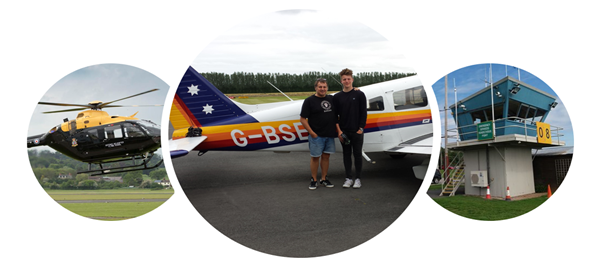My Cranfield MSc: Astronautics and Space Engineering – Pathway to space.
23/02/2021

Where did it all start? How did I become interested in the space sector? I would say that my interest in aerospace originated from my passion for aircraft and helicopters from an early age. I remember I did my high school work experience shadowing an RAF helicopter pilot and was lucky enough to get a few flights with him in the Eurocopter Squirrel HT1 from the Defence Helicopter Flying School out of RAF Shawbury back in 2014.
From then, I developed a real passion towards flying and really wanted to become a fast jet pilot in the RAF. Due to this interest, I took up flying lessons from my local airfield when I was 16 and managed to do my first solo flight before the time I got my driving licence! As I was spending so much time at the airfield, I managed to pick up a part-time job there where I started off as an Air Traffic Service Assistant in the tower.
I continued with this job through college, progressing to an Air Ground Controller after obtaining my Radio Operators Certificate of Competence (ROCC) from the Civil Aviation Authority in 2017 to operate VHF radiotelephony equipment and exchange spoken messages in the aeronautical radio services.
In terms of academia, my strongest subjects were maths and physics, which ultimately lead me to study this combination in college as well, as well as psychology, physical education and an Extended Project Qualification (EPQ) looking into lift generation and aerofoil characteristics. This ultimately then led me to study my BEng in Aerospace Engineering with Pilot Studies down in Bristol.

I only really started to specialise in space flight during my final year, choosing to tailor my elective modules towards spacecraft engineering, which gave me valuable experience in simulation exercises on geometric orbit design, mission and spacecraft systems engineering using the Open Cosmos beeApp simulator as well as analysis of radiation dosage on shielding thickness and spacecraft mean body temperature with the STK Space Environment and Effects Tool.
As my personal interests are within space flight and rocket propulsion systems, this led me to do my final year individual project on an exploration of the design of liquid bi-propellent engines, with a practical investigation into the combustion phase using CFD. For those who don’t know what CFD is, it is Computational Fluid Dynamics, and engineers use it to model fluid flow to simulate real life applications. In my case, this was the chemical reaction of various combinations of fuels and oxidisers and see how they affected the performance of the engine, the specific impulse. I then took this further, and am now studying Astronautics and Space Engineering MSc at Cranfield University.
Categories & Tags:
Leave a comment on this post:
You might also like…
Automotive Engineering: From student to hypercar innovation at Rimac
We sat down with recent graduate Thomas Perrin, to discuss how his year on the MSc in Automotive Engineering at Cranfield University propelled him from the lecture hall directly into the ...
What this year at Cranfield really meant to me
Every Cranfield journey is unique. In this alumni reflection, Zachea Scicluna shares what her year at Cranfield truly meant, from facing uncertainty to gaining hands-on experience in industry-backed projects. I’ve been reflecting (and delaying) ...
Preparing for assignments and exams?
Sorry! We know it seems a bit mean to mention the exams in January rather than looking forward to the break before it! However, we know many of you will be thinking about your forthcoming ...
Screening for FTSE 100 companies on Bloomberg
So you’re researching an index and need some data on its constituent companies? Bloomberg’s Equity Screening tool makes light work of this, not just for the FTSE, but for indices, exchanges and sectors worldwide. Type EQS ...
Accelerating my future: How Cranfield put me on the fast track to automotive safety innovation
Hello! I’m Michaela Kaiser, and I’m thrilled to share my journey studying abroad. I’m from Calgary, Canada, and I recently graduated from Cranfield’s MSc Automotive Engineering course. My path to Cranfield ...
From Myanmar to Cranfield: My path to Renewable Energy
As someone who is passionate about sustainability, my career goal is to build a path in the renewable energy sector. My aspirations comes from the benefits of developing sustainable energy sources and ensuring energy ...






